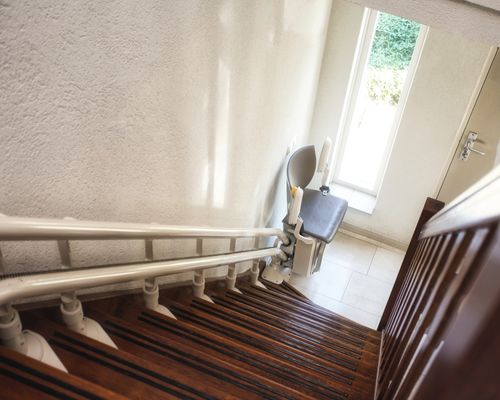Stairlifts are, for many, a life changing piece of equipment. However, for those that don’t need them, they can simply get in the way and gather dust. Maybe you’re clearing out the home of a loved one that’s passed away or perhaps you used a stairlift for a temporary condition and now no longer need it. Whatever your reason, you’re probably wondering how to remove and sell an old stairlift.
Well, look no further. This guide has all the information you need to know to effectively remove that stairlift and reclaim your space.
Can I Sell My Old Stairlift?
It may be possible to sell your stairlift but the one thing that you have to keep in mind is that a lot of stairlifts are bespoke. This particularly applies to those that have been fitted to curved stairs and so it’ll be very difficult to sell them on since the buyer probably wouldn’t be able to install it.
That said, you could advertise the stairlift on things like Gumtree, eBay, Facebook Marketplace and other online selling sites. But you need to state that the buyer should be aware that the stairlift may not necessarily fit their staircase.
Moreover, I’d recommend advertising that the buyer will need to dismantle the stairlift as this will save you the hassle. You may need to offer a slightly lower price if you want them to do this but at least it’ll be out of your hair.
Also keep in mind that selling privately online might mean that you have to wait longer to get rid of the stairlift. I’ve advertised things online before and they’ve taken months to sell. If you’re in no particular rush then this may be OK but if you’re trying to get rid of the stairlift in a hurry, it’s probably not the best option.
Ways To Get Rid Of An Old Stairlift
If you don’t want to go down the route of a private sale then there are other ways you can get rid of your old stairlift. Most of these are less time consuming and won’t require too much work on your part.
Stairlift Removal Service
There are tons of stairlift removal companies that you can find online in your local area. The main issue here is that you will need to pay for the removal whereas with a private sale, you’ll receive money. However, if you’re keen to dispose of the stairlift then the fee probably won’t deter you.
How much it’ll cost to have the stairlift removed will depend on several things and you’ll be given a quote from the company. But generally speaking, the older the stairlift, the more expensive it will be to have it removed. For straight stairlifts, the removal fee is normally around £150 whereas a curved stairlift removal may be double this with an average of £300.
The reason for this fee is the labour that’s required. It’s normally cheaper to remove a straight lift as you’ll only need to have one engineer working on the project. But curved stairlifts are a little more complicated so it’ll often require two people to get the job done. These stairlifts are normally more awkwardly shaped and the rails are usually heavier.
On top of this, your fee will include responsible disposal of the stairlift. Because, after all, if it was that simple, I’d be telling you to just take it to the local tip. There are some legalities that need to be considered when disposing of an old stair lift as well as thinking about getting rid of it in an environmentally friendly manner.
Professional stairlift removal companies will make sure that your old stairlift is taken to an authorised recycling centre. Moreover, since there are many different components to the stairlift, including electricals and batteries, these need to be correctly disposed of and this is reflected in the fee.
In some cases, you might not want the stairlift to be removed permanently. Perhaps you’re having some work done on the home such as a new carpet and need the stairlift out of the way while this takes place. The good news is that most stairlift removal companies will take it out and then reinstall it when you’re ready.
Do note that after you have had your stairlift removed, you will likely be left with some indentations on the carpet where the legs were placed as well as some discoloration to the carpet.
Buy Back Services
A lot of the most reputable stairlift manufacturers offer a buy back service for customers who no longer require their product. However, this doesn’t apply to all stairlifts and you may not qualify based on the age, model and location of the stairlift.
But if you are able to take advantage of this service then it’s well worth considering since you will receive some money back for the equipment. In a lot of cases, you’ll be offered more money than you’d get from selling the stairlift through other means as the company will be able to make use of the equipment and reinstall it elsewhere so they won’t be losing out on any profit.
What’s more, this is a great option since you know you can trust the company. They installed your stairlift and you’re hopefully pleased with how it’s performed and with the installation so you can be confident that they know what they’re doing.
However, you have to consider that most companies will only buy the lift back if it’s less than six months old. In some cases, you may have a cooldown period and this will be your only window of opportunity to remove the stairlift. While it might seem unfair, I’d also urge you to consider the fact the cooldown periods are likely voided if the buyer passes away.
Once the six months are over, these companies may still return to remove the equipment but they certainly won’t give you anything for doing so. In fact, in a lot of cases, you’ll probably have to pay a removal fee. On top of this, you have to keep in mind that there is normally a waiting list. Some of the bigger brands like Stannah may have you waiting a couple of months before they’ll come out. And if it’s busier than usual, they may not come out at all, pausing removals to make more time for new installations.
Donate To Charity
If the stairlift is in good working order then it might be worth donating it to charity. While you may no longer need the lift, there could be someone out there in dire need who cannot afford to purchase their own. Since the money you’d get for a private sale would be minimal, this is something a lot of people consider.
One of the main advantages of doing this is that you are helping someone else. There’s no greater feeling than knowing that you’ve given somebody something they desperately need but couldn’t have.
However, donating to charity isn’t as simple as dumping the stairlift and forgetting about it. In fact, you’ll find that charities can be very picky about what they take. That’s not them being difficult, it’s to make sure that the equipment is safe for further use. This means that they may require electrical tests and all the relevant certifications and documents that go with the stairlift.
In a lot of situations, you’ll find that charities will not accept stairlifts even with all the relevant documentation since there are risks with the electrical components. On top of this, stairlifts are often bespoke so it can be difficult to reinstall them elsewhere which can be off putting to charities. Some charities also consider hygiene when decided whether to take a stairlift. Since the seat is typically made with fabric, it cannot be wiped clean, this may be a reason that you receive a thanks but no thanks.
You also have to consider that while you will be giving the stairlift away, you’ll still need to have it removed. This means hiring a tradesperson to come out and this will of course come with a fee.
Conclusion
An unwanted stairlift can be a real hindrance so it doesn’t surprise me that you’re keen to get it out of the way. But since these are bespoke items that don’t have a high resale value, they can be difficult to shift.
Private sales and donating to charity are options but you’ll typically have to hire a removal service if you want the thing gone. Some stairlift manufacturers do offer a buy back service but these are usually fraught with T&Cs and you may even have to pay a fee as opposed to them paying you!

